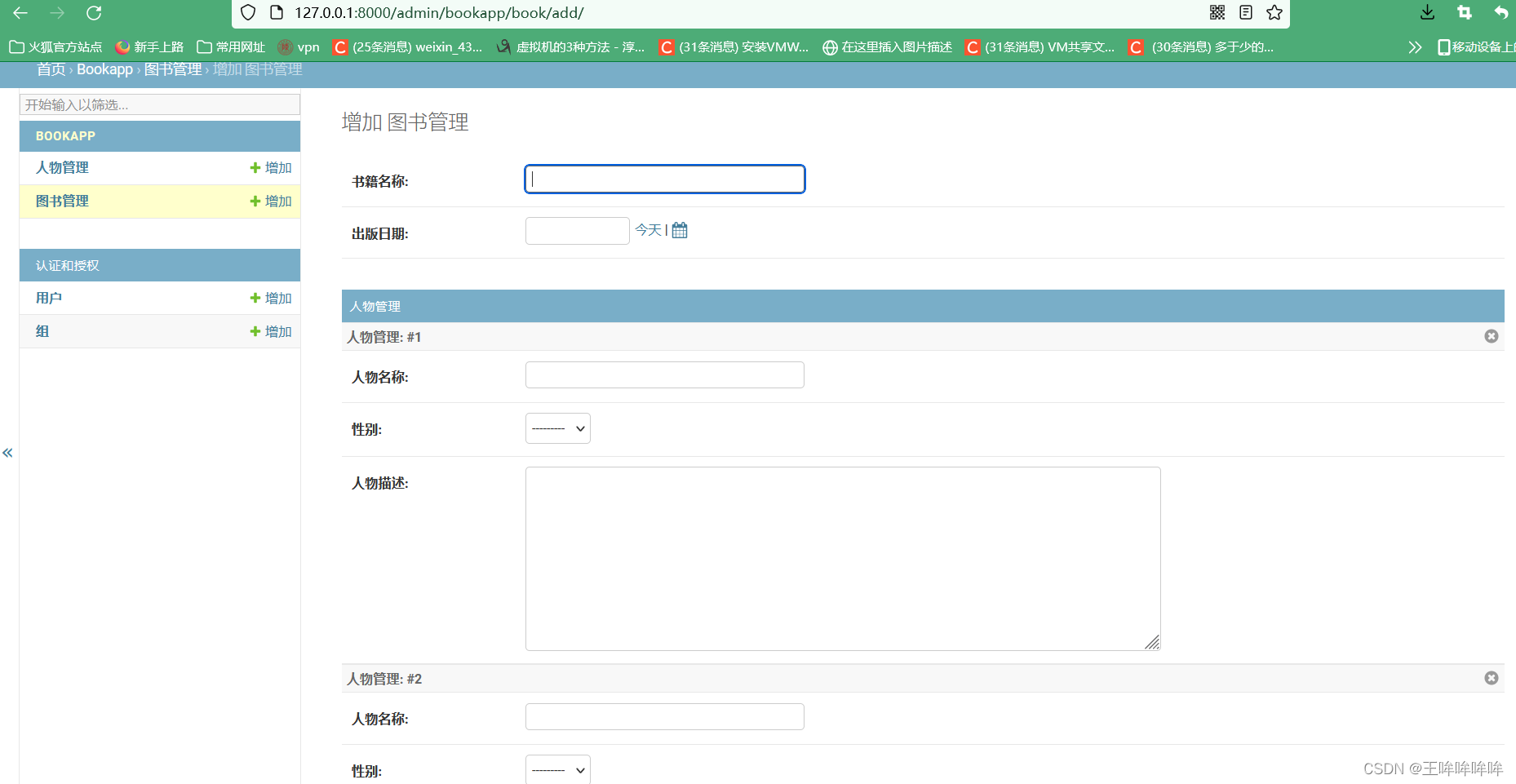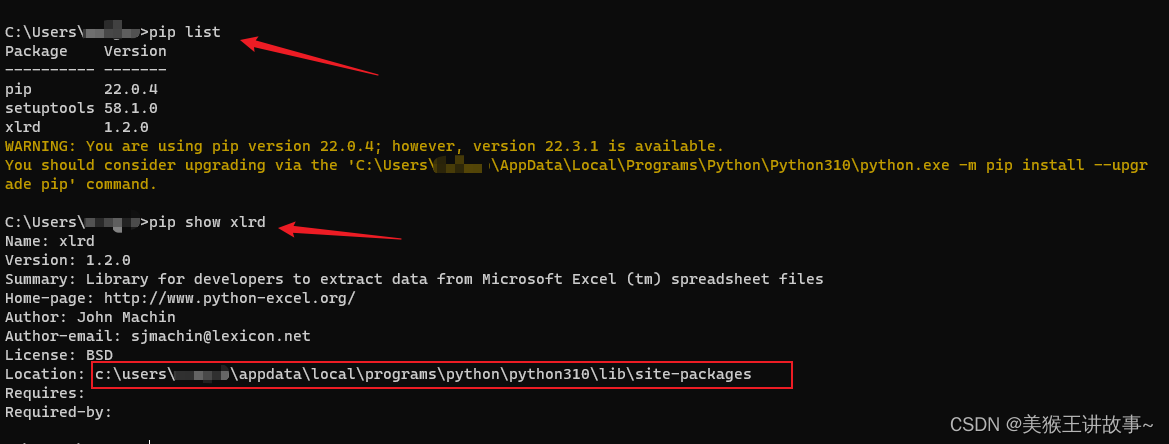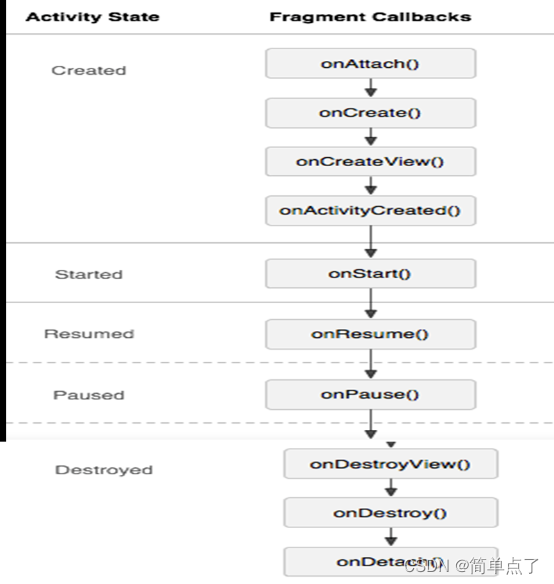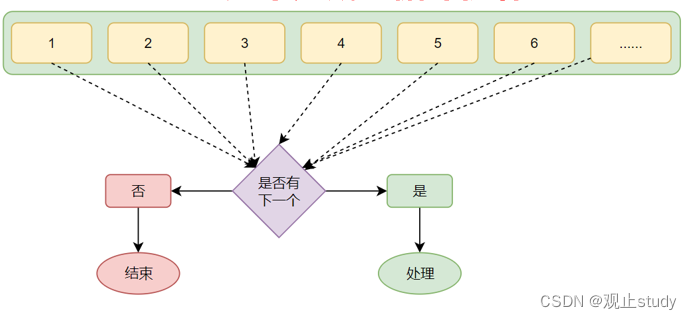如何阅读源码
网上有很多关于源码阅读的文章,每个人都有自己的方式,但是网上的文章都是精炼之后的,告诉你哪个文件、那个函数、那个变量是干什么的;
但是没有告诉你这些是怎么找到的,这些是怎么理解的,这些是怎么验证的,这些是怎么记忆的,这些是怎么应用的。
我也不是什么大神,也是在摸索的过程中,逐渐找到了自己的方式,我这里就分享一下我的方式,希望能帮助到大家。
怎么找到起点
万事开头难,找到起点是最难的,对于前端项目,我们想要找到入口文件,一般都是从package.json中的main字段开始找;
package.json中的main字段代表的是这个包的入口文件,通常我们可以通过这个字段的值来找到我们要阅读的起点。
但是对于Vue来说,这个字段是dist/vue.runtime.common.js,这个文件是编译后的文件,我们是看不懂的,所以需要找到源码的入口文件;
这个时候我们就需要看package.json中的scripts字段:
{
"scripts": {"dev": "rollup -w -c scripts/config.js --environment TARGET:full-dev","dev:cjs": "rollup -w -c scripts/config.js --environment TARGET:runtime-cjs-dev","dev:esm": "rollup -w -c scripts/config.js --environment TARGET:runtime-esm","dev:ssr": "rollup -w -c scripts/config.js --environment TARGET:server-renderer","dev:compiler": "rollup -w -c scripts/config.js --environment TARGET:compiler ","build": "node scripts/build.js","build:ssr": "npm run build -- runtime-cjs,server-renderer","build:types": "rimraf temp && tsc --declaration --emitDeclarationOnly --outDir temp && api-extractor run && api-extractor run -c packages/compiler-sfc/api-extractor.json","test": "npm run ts-check && npm run test:types && npm run test:unit && npm run test:e2e && npm run test:ssr && npm run test:sfc","test:unit": "vitest run test/unit","test:ssr": "npm run build:ssr && vitest run server-renderer","test:sfc": "vitest run compiler-sfc","test:e2e": "npm run build -- full-prod,server-renderer-basic && vitest run test/e2e","test:transition": "karma start test/transition/karma.conf.js","test:types": "npm run build:types && tsc -p ./types/tsconfig.json","format": "prettier --write --parser typescript "(src|test|packages|types)/**/*.ts"","ts-check": "tsc -p tsconfig.json --noEmit","ts-check:test": "tsc -p test/tsconfig.json --noEmit","bench:ssr": "npm run build:ssr && node benchmarks/ssr/renderToString.js && node benchmarks/ssr/renderToStream.js","release": "node scripts/release.js","changelog": "conventional-changelog -p angular -i CHANGELOG.md -s"}
}
可以看到Vue的package.json中有很多的scripts,这些相信大家都可以看得懂,这里我们只关注dev和build这两个脚本;
dev脚本是用来开发的,build脚本是用来打包的,我们可以看到dev脚本中有一个TARGET的环境变量,这个环境变量的值是full-dev,我们可以在scripts/config.js中找到这个值;
直接在scripts/config.js中搜索full-dev:
这样就可以找到这个值对应的配置:
var config = {'full-dev': {entry: resolve('web/entry-runtime-with-compiler.ts'),dest: resolve('dist/vue.js'),format: 'umd',env: 'development',alias: { he: './entity-decoder' },banner}
}
entry字段就是我们要找的入口文件,这个文件就是Vue的源码入口文件,后面的值是web/entry-runtime-with-compiler.ts,我们可以在web目录下找到这个文件;
但是并没有在根目录下找到web目录,这个时候我们就大胆猜测,是不是有别名配置,这个时候我也正好在scripts下看到了一个alias.js文件,打开这个文件,发现里面有一个web的别名;
代码如下:
module.exports = {vue: resolve('src/platforms/web/entry-runtime-with-compiler'),compiler: resolve('src/compiler'),core: resolve('src/core'),web: resolve('src/platforms/web'),weex: resolve('src/platforms/weex'),shared: resolve('src/shared')
}
为了验证我们的猜测,我们可以在config.js中搜一下alias,发现确实有引入这个文件:
const aliases = require('./alias')
const resolve = p => {const base = p.split('/')[0]if (aliases[base]) {return path.resolve(aliases[base], p.slice(base.length + 1))} else {return path.resolve(__dirname, '../', p)}
}
再搜一下aliases,发现确实有配置别名:
// 省略部分代码
const config = {plugins: [alias({entries: Object.assign({}, aliases, opts.alias)}),].concat(opts.plugins || []),
}
这样我们就可以确认,web就是src/platforms/web这个目录,我们可以在这个目录下找到entry-runtime-with-compiler.ts这个文件;
这样我们就成功的找到了Vue的源码入口文件,接下来我们就可以开始阅读源码了;
如何阅读源码
上面找到了入口文件,但是还是不知道如何阅读源码,这个时候我们就需要一些技巧了,这里我就分享一下我自己的阅读源码的技巧;
像我们现在看的源码几乎都是使用esm模块化或者commonjs模块化的,这些都会有一个export或者module.exports,我们可以通过这个来看导出了什么;
只看导出的内容,其他的暂时不用管,直接找到最终导出的内容,例如Vue的源码:
1.entry-runtime-with-compiler.ts的导出内容:
import Vue from './runtime-with-compiler'
export default Vue
这个时候就去找runtime-with-compiler.ts的导出内容:
2.runtime-with-compiler.ts的导出内容:
import Vue from './runtime/index'
export default Vue as GlobalAPI
这个时候就去找runtime/index.ts的导出内容:
3.runtime/index.ts的导出内容:
import Vue from 'core/index'
export default Vue
这个时候就去找core/index.ts的导出内容:
4.core/index.ts的导出内容:
import Vue from './instance/index'
export default Vue
这个时候就去找instance/index.ts的导出内容:
5.instance/index.ts的导出内容:
function Vue(options) {if (__DEV__ && !(this instanceof Vue)) {warn('Vue is a constructor and should be called with the `new` keyword')}this._init(options)
}
export default Vue as unknown as GlobalAPI
这样我们就找到Vue的构造函数了,这个时候我们就可以开始阅读源码了;
带有目的的阅读源码
阅读源码的目的一定要清晰,当然你可以说目的就是了解Vue的实现原理,但是这个目的太宽泛了,我们可以把目的细化一下,例如:
1.Vue的生命周期是怎么实现的
2.Vue的数据响应式是怎么实现的
3.Vue的模板编译是怎么实现的
4.Vue的组件化是怎么实现的
5.Vue的插槽是怎么实现的
6.等等…
例如我们的这次阅读计划就是了解Vue的this为什么可以访问到选项中的各种属性,这里再细分为:
1.Vue的this是怎么访问到data的
2.Vue的this是怎么访问到methods的
3.Vue的this是怎么访问到computed的
4.Vue的this是怎么访问到props的
上面顺序不分先后,但是答案一定是在源码中。
源码分析
上面已经找到了Vue的入口文件,接下来我们就可以开始阅读源码了,这里我就以Vue的this为什么可以访问到选项中的各种属性为例,来分析Vue的源码;
首先看一下instance/index.ts的源码:
import { initMixin } from './init'
import { stateMixin } from './state'
import { renderMixin } from './render'
import { eventsMixin } from './events'
import { lifecycleMixin } from './lifecycle'
import { warn } from '../util/index'
import type { GlobalAPI } from 'types/global-api'
function Vue(options) {if (__DEV__ && !(this instanceof Vue)) {warn('Vue is a constructor and should be called with the `new` keyword')}this._init(options)
}
//@ts-expect-error Vue has function type
initMixin(Vue)
//@ts-expect-error Vue has function type
stateMixin(Vue)
//@ts-expect-error Vue has function type
eventsMixin(Vue)
//@ts-expect-error Vue has function type
lifecycleMixin(Vue)
//@ts-expect-error Vue has function type
renderMixin(Vue)
export default Vue as unknown as GlobalAPI
有这么多东西,我们不用管,要清晰目的,我们在使用Vue的时候,通常是下面这样的:
const vm = new Vue({data() {return {msg: 'hello world'}},methods: {say() {console.log(this.msg)}}
});
vm.say();
也就是Vue的构造函数接收一个选项对象,这个选项对象中有data和methods;
我们要知道Vue的this为什么可以访问到data和methods,那么我们就要找到Vue的构造函数中是怎么把data和methods挂载到this上的;
很明显构造函数只做了一件事,就是调用了this._init(options):
this._init(options)
那么我们就去找_init方法,这个方法在哪我们不知道,但是继续分析源码,我们可以看到下面会执行很多xxxMixin的函数,并且Vue作为参数传入:
//@ts-expect-error Vue has function type
initMixin(Vue)
//@ts-expect-error Vue has function type
stateMixin(Vue)
//@ts-expect-error Vue has function type
eventsMixin(Vue)
//@ts-expect-error Vue has function type
lifecycleMixin(Vue)
//@ts-expect-error Vue has function type
renderMixin(Vue)
盲猜一波,见名知意:
1.initMixin:初始化混入
2.stateMixin:状态混入
3.eventsMixin:事件混入
4.lifecycleMixin:生命周期混入
5.renderMixin:渲染混入
我们就去找这些混入的方法,一个一个的找,找到initMixin,直接就找了_init方法:
export function initMixin(Vue: typeof Component) {Vue.prototype._init = function (options?: Record<string, any>) {const vm: Component = this// a uidvm._uid = uid++let startTag, endTag/* istanbul ignore if */if (__DEV__ && config.performance && mark) {startTag = `vue-perf-start:${vm._uid}`endTag = `vue-perf-end:${vm._uid}`mark(startTag)}// a flag to mark this as a Vue instance without having to do instanceof// checkvm._isVue = true// avoid instances from being observedvm.__v_skip = true// effect scopevm._scope = new EffectScope(true /* detached */)vm._scope._vm = true// merge optionsif (options && options._isComponent) {// optimize internal component instantiation// since dynamic options merging is pretty slow, and none of the// internal component options needs special treatment.initInternalComponent(vm, options as any)} else {vm.$options = mergeOptions(resolveConstructorOptions(vm.constructor as any),options || {},vm)}/* istanbul ignore else */if (__DEV__) {initProxy(vm)} else {vm._renderProxy = vm}// expose real selfvm._self = vminitLifecycle(vm)initEvents(vm)initRender(vm)callHook(vm, 'beforeCreate', undefined, false /* setContext */)initInjections(vm) // resolve injections before data/propsinitState(vm)initProvide(vm) // resolve provide after data/propscallHook(vm, 'created')/* istanbul ignore if */if (__DEV__ && config.performance && mark) {vm._name = formatComponentName(vm, false)mark(endTag)measure(`vue ${vm._name} init`, startTag, endTag)}if (vm.$options.el) {vm.$mount(vm.$options.el)}}
}
代码这么多没必要全都看,记住我们的目的是找到data和methods是怎么挂载到this上的;
先简化代码,不看没有意义的代码:
export function initMixin(Vue) {Vue.prototype._init = function (options) {const vm = this}
}
传递过来的Vue并没有做太多事情,只是把_init方法挂载到了Vue.prototype上;
在_init方法中,vm被赋值为this,这里的this就是Vue的实例,也就是我们的vm;
继续往下看,我们有目的的看代码,只需要看有vm和options组合出现的代码,于是就看到了:
if (options && options._isComponent) {initInternalComponent(vm, options)
} else {vm.$options = mergeOptions(resolveConstructorOptions(vm.constructor),options || {},vm)
}
_isComponent前面带有_,说明是私有属性,我们通过new Vue创建的实例时走到现在是没有这个属性的,所以走到else分支;
resolveConstructorOptions(vm.constructor)中没有传递options,所以不看这个方法,直接看mergeOptions:
export function mergeOptions(parent, child, vm) {if (__DEV__) {checkComponents(child)}if (isFunction(child)) {// @ts-expect-errorchild = child.options}normalizeProps(child, vm)normalizeInject(child, vm)normalizeDirectives(child)// Apply extends and mixins on the child options,// but only if it is a raw options object that isn't// the result of another mergeOptions call.// Only merged options has the _base property.if (!child._base) {if (child.extends) {parent = mergeOptions(parent, child.extends, vm)}if (child.mixins) {for (let i = 0, l = child.mixins.length; i < l; i++) {parent = mergeOptions(parent, child.mixins[i], vm)}}}const options = {}let keyfor (key in parent) {mergeField(key)}for (key in child) {if (!hasOwn(parent, key)) {mergeField(key)}}function mergeField(key) {const strat = strats[key] || defaultStratoptions[key] = strat(parent[key], child[key], vm, key)}return options
}
记住我们的目的,只需要关心vm和options组合出现的代码,child就是options,vm就是vm,简化之后:
export function mergeOptions(parent, child, vm) {normalizeProps(child, vm)normalizeInject(child, vm)normalizeDirectives(child)return options
}
可以看到只剩下了normalizeProps、normalizeInject、normalizeDirectives这三个方法,值得我们关注,但是见名知意,这三个方法可能并不是我们想要的,跟进去看一眼也确实不是;
虽然没有得到我们想要的,但是从这里我们也得到了一个重要信息,mergeOptions最后会返回一个options对象,这个对象就是我们的options,最后被vm.$options接收;
vm.$options = mergeOptions(resolveConstructorOptions(vm.constructor),options || {},vm)
现在我们分析要多一步了,参数只有vm的函数也是需要引起我们的注意的,继续往下看:
if (__DEV__) {initProxy(vm)
} else {vm._renderProxy = vm
}
操作了vm,但是内部没有操作$options,跳过,继续往下看:
initLifecycle(vm)
initEvents(vm)
initRender(vm)
callHook(vm, 'beforeCreate', undefined, false /* setContext */)
initInjections(vm) // resolve injections before data/props
initState(vm)
initProvide(vm) // resolve provide after data/props
callHook(vm, 'created')
initLifecycle、initEvents、initRender、initInjections、initState、initProvide这些方法都是操作vm的;
盲猜一波:
initLifecycle:初始化生命周期initEvents:初始化事件initRender:初始化渲染initInjections:初始化注入initState:初始化状态initProvide:初始化依赖注入callHook:调用钩子
这里面最有可能是我们想要的是initState,跟进去看一下:
export function initState(vm) {const opts = vm.$optionsif (opts.props) initProps(vm, opts.props)// Composition APIinitSetup(vm)if (opts.methods) initMethods(vm, opts.methods)if (opts.data) {initData(vm)} else {const ob = observe((vm._data = {}))ob && ob.vmCount++}if (opts.computed) initComputed(vm, opts.computed)if (opts.watch && opts.watch !== nativeWatch) {initWatch(vm, opts.watch)}
}
已经找到我们想要的了,现在开始正式分析initState。
initState
根据代码结构可以看到,initState主要做了以下几件事:
- 初始化
props - 初始化
setup - 初始化
methods - 初始化
data - 初始化
computed - 初始化
watch
我们可以用this来访问的属性是props、methods、data、computed;
看到这里也明白了,为什么在props中定义了一个属性,在data、methods、computed中就不能再定义了,因为props是最先初始化的,后面的也是同理。
initProps
initProps的作用是初始化props,跟进去看一下:
function initProps(vm, propsOptions) {const propsData = vm.$options.propsData || {}const props = (vm._props = shallowReactive({}))// cache prop keys so that future props updates can iterate using Array// instead of dynamic object key enumeration.const keys = (vm.$options._propKeys = [])const isRoot = !vm.$parent// root instance props should be convertedif (!isRoot) {toggleObserving(false)}for (const key in propsOptions) {keys.push(key)const value = validateProp(key, propsOptions, propsData, vm)/* istanbul ignore else */if (__DEV__) {const hyphenatedKey = hyphenate(key)if (isReservedAttribute(hyphenatedKey) ||config.isReservedAttr(hyphenatedKey)) {warn(`"${hyphenatedKey}" is a reserved attribute and cannot be used as component prop.`,vm)}defineReactive(props, key, value, () => {if (!isRoot && !isUpdatingChildComponent) {warn(`Avoid mutating a prop directly since the value will be ` +`overwritten whenever the parent component re-renders. ` +`Instead, use a data or computed property based on the prop's ` +`value. Prop being mutated: "${key}"`,vm)}})} else {defineReactive(props, key, value)}// static props are already proxied on the component's prototype// during Vue.extend(). We only need to proxy props defined at// instantiation here.if (!(key in vm)) {proxy(vm, `_props`, key)}}toggleObserving(true)
}
代码很多,我们依然不用关心其他的代码,只关心props是怎么挂载到vm上的,根据我上面的方法,简化后的代码如下:
function initProps(vm, propsOptions) {vm._props = shallowReactive({})for (const key in propsOptions) {const value = validateProp(key, propsOptions, propsData, vm)if (!(key in vm)) {proxy(vm, `_props`, key)}}
}
这里真正有关的就两个地方:
1.validateProp:看名字就知道是验证props,跳过
2.proxy:代理,很可疑,跟进去看一下:
export function proxy(target, sourceKey, key) {sharedPropertyDefinition.get = function proxyGetter() {return this[sourceKey][key]}sharedPropertyDefinition.set = function proxySetter(val) {this[sourceKey][key] = val}Object.defineProperty(target, key, sharedPropertyDefinition)
}
这里的target就是vm,sourceKey就是_props,key就是props的属性名;
这里通过Object.defineProperty把vm的属性代理到_props上,这样就可以通过this访问到props了。
不是很好理解,那我们来自己就用这些代码实现一下:
var options = {props: {name: {type: String,default: 'default name'}}
}
function Vue(options) {const vm = thisinitProps(vm, options.props)
}
function initProps(vm, propsOptions) {vm._props = {}for (const key in propsOptions) {proxy(vm, `_props`, key)}
}
function proxy(target, sourceKey, key) {Object.defineProperty(target, key, {get() {return this[sourceKey][key]},set(val) {this[sourceKey][key] = val}})
}
const vm = new Vue(options)
console.log(vm.name);
console.log(vm._props.name);
vm.name = 'name'
console.log(vm.name);
console.log(vm._props.name);
上面的代码只是为了方便理解,所以会忽略一些细节,比如
props的验证等等,真实挂载在_props上的props是通过defineReactive实现的,我这里直接是空的,这些超出了本文的范围。
initMethods
initMethods的代码如下:
function initMethods(vm, methods) {const props = vm.$options.propsfor (const key in methods) {if (__DEV__) {if (typeof methods[key] !== 'function') {warn(`Method "${key}" has type "${typeof methods[key]}" in the component definition. ` +`Did you reference the function correctly?`,vm)}if (props && hasOwn(props, key)) {warn(`Method "${key}" has already been defined as a prop.`, vm)}if (key in vm && isReserved(key)) {warn(`Method "${key}" conflicts with an existing Vue instance method. ` +`Avoid defining component methods that start with _ or $.`)}}vm[key] = typeof methods[key] !== 'function' ? noop : bind(methods[key], vm)}
}
跟着之前的思路,我们忽略无关代码,简化后的代码如下:
function initMethods(vm, methods) {for (const key in methods) {vm[key] = typeof methods[key] !== 'function' ? noop : bind(methods[key], vm)}
}
这里的vm[key]就是methods的方法,这样就可以通过this访问到methods中定义的方法了。
bind的作用是把methods中定义的函数的this指向vm,这样就可以在methods中使用this就是vm了。
简单的实现一下:
var options = {methods: {say() {console.log('say');}}
}
function Vue(options) {const vm = thisinitMethods(vm, options.methods)
}
function initMethods(vm, methods) {for (const key in methods) {vm[key] = typeof methods[key] !== 'function' ? noop : bind(methods[key], vm)}
}
function noop() {}
function polyfillBind(fn, ctx) {function boundFn(a) {const l = arguments.lengthreturn l? l > 1? fn.apply(ctx, arguments): fn.call(ctx, a): fn.call(ctx)}boundFn._length = fn.lengthreturn boundFn
}
function nativeBind(fn, ctx) {return fn.bind(ctx)
}
const bind = Function.prototype.bind ? nativeBind : polyfillBind
const vm = new Vue(options)
vm.say()
initData
initData的代码如下:
function initData(vm) {let data = vm.$options.datadata = vm._data = isFunction(data) ? getData(data, vm) : data || {}if (<img src="https://v2.vuejs.org/v2/guide/components.html#data-Must-Be-a-Function',vm)}// proxy data on instanceconst keys = Object.keys(data)const props = vm.$options.propsconst methods = vm.$options.methodslet i = keys.lengthwhile (i--) {const key = keys[i]if (__DEV__) {if (methods && hasOwn(methods, key)) {warn(`Method "${key}" has already been defined as a data property.`, vm)}}if (props && hasOwn(props, key)) {__DEV__ &&warn(`The data property "${key}" is already declared as a prop. ` +`Use prop default value instead.`,vm)} else if (!isReserved(key)) {proxy(vm, `_data`, key)}}// observe dataconst ob = observe(data)ob && ob.vmCount+" style="margin: auto" />
}
简化之后的代码如下:
function initData(vm) {let data = vm.$options.data// proxy data on instanceconst keys = Object.keys(data)let i = keys.lengthwhile (i--) {const key = keys[i]proxy(vm, `_data`, key)}
}
这里的实现方式和initProps是一样的,都是通过proxy把data中的属性代理到vm上。
注意:
initData的获取值的地方是其他的不相同,这里只做提醒,不做详细分析。
initComputed
initComputed的代码如下:
function initComputed(vm, computed) {// $flow-disable-lineconst watchers = (vm._computedWatchers = Object.create(null))// computed properties are just getters during SSRconst isSSR = isServerRendering()for (const key in computed) {const userDef = computed[key]const getter = isFunction(userDef) ? userDef : userDef.getif (__DEV__ && getter == null) {warn(`Getter is missing for computed property "${key}".`, vm)}if (!isSSR) {// create internal watcher for the computed property.watchers[key] = new Watcher(vm,getter || noop,noop,computedWatcherOptions)}// component-defined computed properties are already defined on the// component prototype. We only need to define computed properties defined// at instantiation here.if (!(key in vm)) {defineComputed(vm, key, userDef)} else if (__DEV__) {if (key in vm.$data) {warn(`The computed property "${key}" is already defined in data.`, vm)} else if (vm.$options.props && key in vm.$options.props) {warn(`The computed property "${key}" is already defined as a prop.`, vm)} else if (vm.$options.methods && key in vm.$options.methods) {warn(`The computed property "${key}" is already defined as a method.`,vm)}}}
}
简化之后的代码如下:
function initComputed(vm, computed) {for (const key in computed) {const userDef = computed[key]const getter = userDefdefineComputed(vm, key, userDef)}
}
这里的实现主要是通过defineComputed来定义computed属性,进去瞅瞅:
export function defineComputed(target, key, userDef) {const shouldCache = !isServerRendering()if (isFunction(userDef)) {sharedPropertyDefinition.get = shouldCache? createComputedGetter(key): createGetterInvoker(userDef)sharedPropertyDefinition.set = noop} else {sharedPropertyDefinition.get = userDef.get? shouldCache && userDef.cache !== false? createComputedGetter(key): createGetterInvoker(userDef.get): noopsharedPropertyDefinition.set = userDef.set || noop}if (__DEV__ && sharedPropertyDefinition.set === noop) {sharedPropertyDefinition.set = function () {warn(`Computed property "${key}" was assigned to but it has no setter.`,this)}}Object.defineProperty(target, key, sharedPropertyDefinition)
}
仔细看下来,其实实现方式还是和initProps和initData一样,都是通过Object.defineProperty来定义属性;
不过里面的getter和setter是通过createComputedGetter和createGetterInvoker来创建的,这里不做过多分析。
动手时间
上面我们已经分析了props、methods、data、computed的属性为什么可以直接通过this来访问,那么我们现在就来实现一下这个功能。
上面已经简单了实现了initProps、initMethods,而initData和initComputed的实现方式和initProps的方式一样,所以我们直接复用就好了:
function Vue(options) {this._init(options)
}
Vue.prototype._init = function (options) {const vm = thisvm.$options = optionsinitState(vm)
}
function initState(vm) {const opts = vm.$optionsif (opts.props) initProps(vm, opts.props)if (opts.methods) initMethods(vm, opts.methods)if (opts.data) initData(vm)if (opts.computed) initComputed(vm, opts.computed)
}
function initProps(vm, propsOptions) {vm._props = {}for (const key in propsOptions) {vm._props[key] = propsOptions[key].defaultproxy(vm, `_props`, key)}
}
function proxy(target, sourceKey, key) {Object.defineProperty(target, key, {get() {return this[sourceKey][key]},set(val) {this[sourceKey][key] = val}})
}
function initMethods(vm, methods) {for (const key in methods) {vm[key] = typeof methods[key] !== 'function' ? noop : bind(methods[key], vm)}
}
function noop() {}
function polyfillBind(fn, ctx) {function boundFn(a) {const l = arguments.lengthreturn l? l > 1? fn.apply(ctx, arguments): fn.call(ctx, a): fn.call(ctx)}boundFn._length = fn.lengthreturn boundFn
}
function nativeBind(fn, ctx) {return fn.bind(ctx)
}
const bind = Function.prototype.bind ? nativeBind : polyfillBind
function initData(vm) {vm._data = {}for (const key in vm.$options.data) {vm._data[key] = vm.$options.data[key]proxy(vm, `_data`, key)}
}
function initComputed(vm, computed) {for (const key in computed) {const userDef = computed[key]const getter = userDefdefineComputed(vm, key, bind(userDef, vm))}
}
function defineComputed(target, key, userDef) {Object.defineProperty(target, key, {get() {return userDef()},})
}
const vm = new Vue({props: {a: {type: String,default: 'default'}},data: {b: 1},methods: {c() {console.log(this.b)}},computed: {d() {return this.b + 1}}
})
console.log('props a: default',vm.a)
console.log('data b: 1', vm.b)
vm.c() // 1
console.log('computed d: 2', vm.d)
注意:上面的代码对比于文章中写的示例有改动,主要是为了实现最后打印结果正确,增加了赋值操作。
总结
通过上面的分析,让我们对构造函数的this有了更深的理解,同时对于this指向的问题也有了更深的理解。
最后
整理了75个JS高频面试题,并给出了答案和解析,基本上可以保证你能应付面试官关于JS的提问。
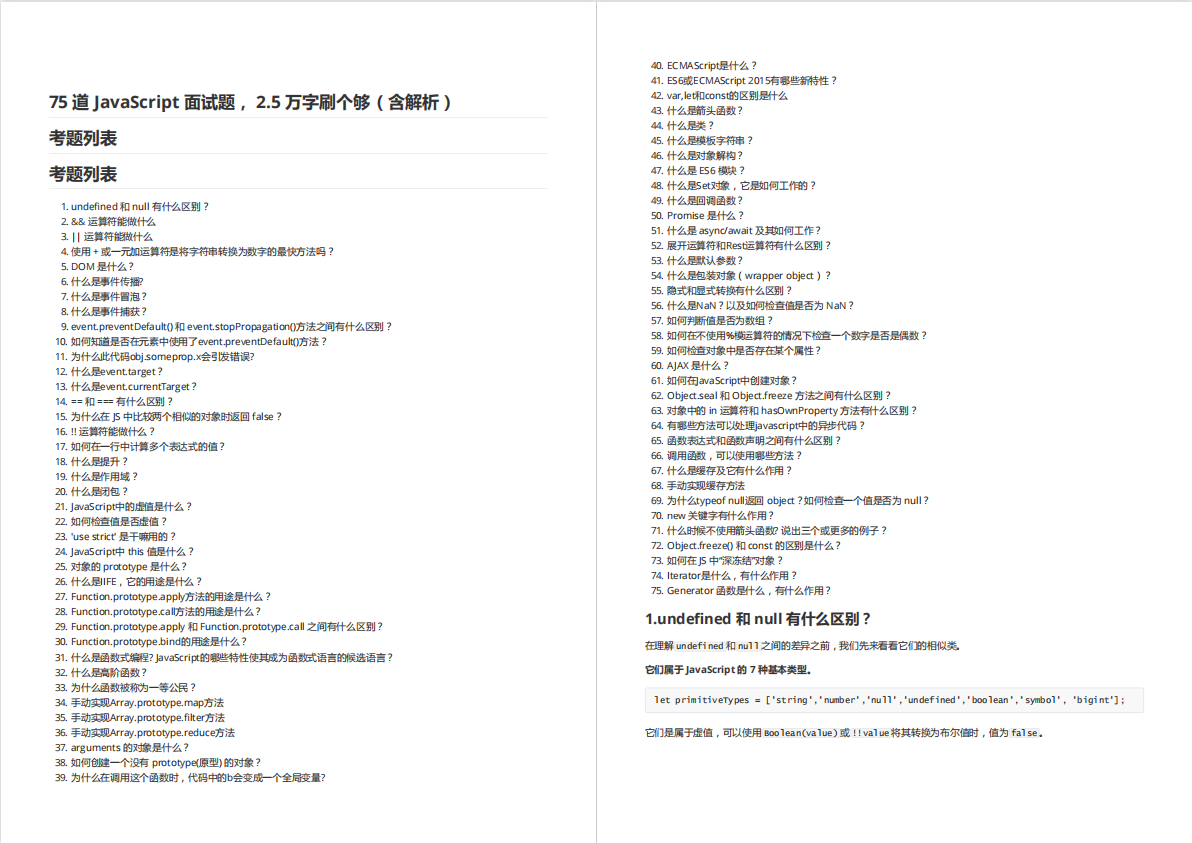

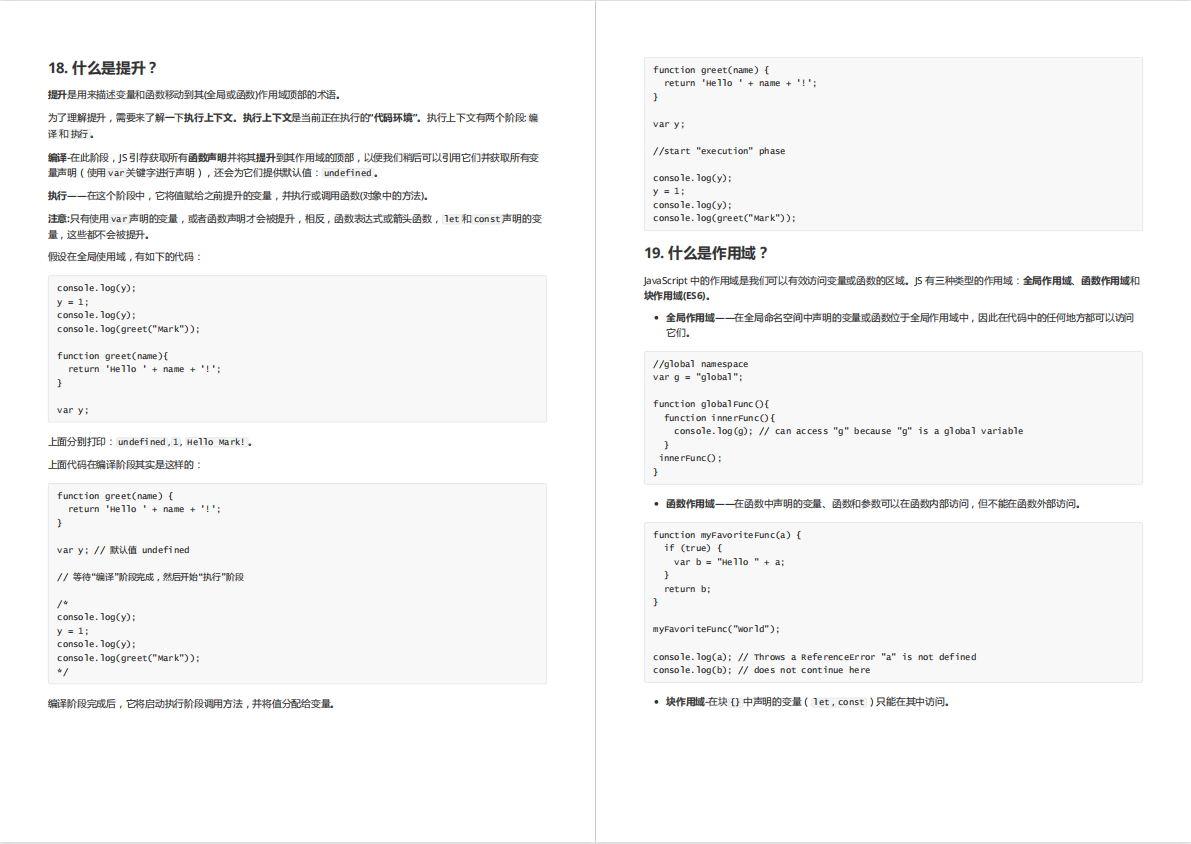
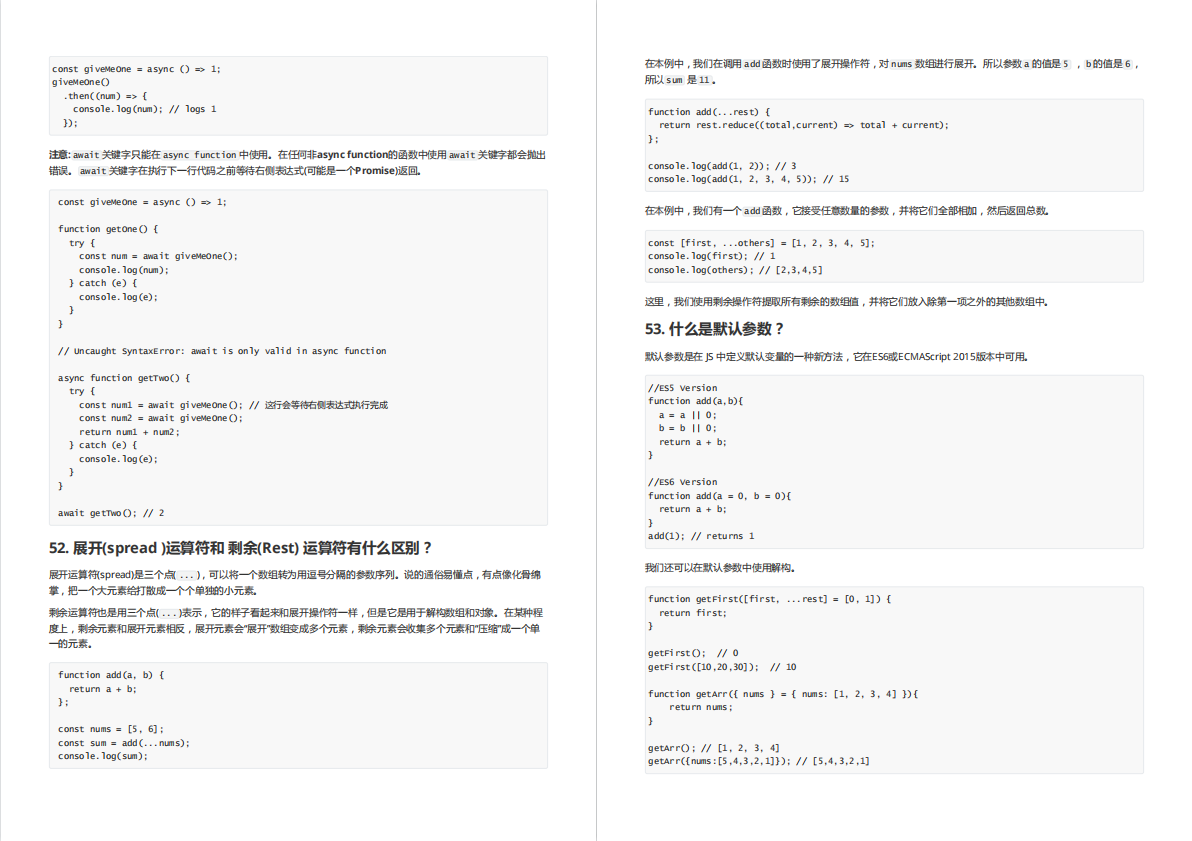
有需要的小伙伴,可以点击下方卡片领取,无偿分享


